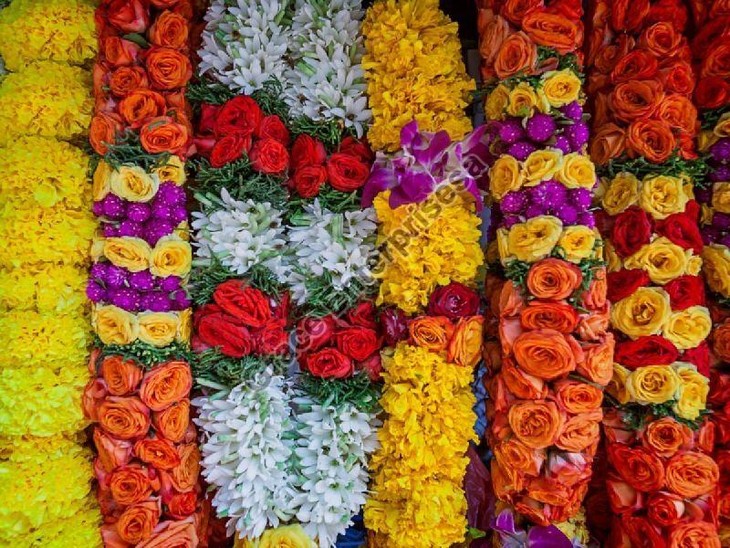(VOVWORLD) - India is famous for its culture and traditions, like its lovely traditional way of welcoming guests. Welcoming a guest is an expression of a person's cultural sensitivities and worldview. Each culture has its own way of welcoming a guest. In Indian tradition, guests are garlanded, and a red dot is applied to their forehead as a mark of honor and respect.
Although we arrived in India at midnight, the members of a Vietnamese familiarization delegation who had come to explore Buddhist destinations in Uttar Pradesh felt the warmth and hospitality of Indians who greeted us with friendly hugs, big smiles, and garlands of fresh flowers. In India, flower garlands are often offered to visitors as a mark of respect and honor.
Priya Singh, a tourism officer in Kapilvastu, the Indian northern state of Uttar Pradesh, a city widely known as an International Buddhist Pilgrimage Centre, said they often use flower garlands as offerings at a puja (prayer session) or as decoration for religious festivals like Durga Puja or for Buddhist occasions.
“We also use them to welcome guests, because we believe that when someone from outside comes here, we should welcome them in a way that leaves a good impression,” Priya Singh noted.
 Lovely flower garlands are sure to be spotted on any trip to India because flower garlands hold a place in the Indian culture. Lovely flower garlands are sure to be spotted on any trip to India because flower garlands hold a place in the Indian culture.
|
The garlands are created from whatever fresh flowers are grown locally, but orange marigolds are preferred, said Priya Singh, adding, “When guests come we give them roses, lilies, or marigolds because they look very good and very cute. I think marigolds are associated with every God, not a particular God.”
In many places holy seeds as well as flowers are used to make garlands. The most common seeds are Rudraksha beads and tulsi, commonly known as holy basil, which symbolizes purity and good fortune in Hinduism and is said to keep negativity away.
“Tulsi is a very important plant for us because it emits lots of oxygen. People worship it, especially in the winter, and during Hanuman Jayanti (birthday celebration for the monkey god Hanuman). Tulsi mala is a tradition here,” said Priya Singh.
According to Priya Singh, during the month of Kartik (8th month of the Hindu calendar, which falls in October-November), people take a bath with tulsi seeds. It’s also the month in which Lord Shiva and Goddess Parvati were married, so people water the tulsi plant every morning. On Tuesday, people offer tulsi mala to Lord Hanuman at a puja session.
Applying a red dot (called a tilak) to the forehead between the eyebrows is a way to honor and bless a guest. A tilak symbolizes warm wishes for the well-being of the person to whom it is applied. This is the highest form of welcome in India.
Swami Purnachaitanya, an expert on Yoga, Meditation, Mantras, Ayurveda, and Vedic Wisdom and Director of Programs of The Art of Living, said there are different ways of doing it and in different schools and different sects they apply it differently, but there is a beautiful scientific idea behind it.
“They used to say that this is the ‘devasthanam’, the place where the Gods reside in the body, so it should not be left empty. We should apply something at least. But they apply different natural substances,” according to Swami Purnachaitanya.
 Tourists are welcomed with the custom to apply tilal (Photo: Do Hien) Tourists are welcomed with the custom to apply tilal (Photo: Do Hien)
|
A tilak usually consists of a vermilion paste called “kumkum” in Sanskrit which is a mixture of turmeric, alum, iodine, and camphor. It can also be a sandalwood paste called “chandan”, which contains musk.
He noted that these natural substances have some beautiful qualities and took an example of chandan, the sandalwood paste which has a cooling effect.
“When it dries, it naturally draws the attention to the Ajna Chakra, the point between the eyebrows, stimulating the glands there - the pituitary gland and the pineal gland. When the pineal gland gets stimulated it makes us more aware, more alert, and has a positive effect on the body,” the Indian expert said.
All rites and ceremonies of the Hindus begin with a tilak topped with a few grains of rice placed on the spot with the index finger or the thumb. The same custom is followed when welcoming or bidding farewell to guests or relatives.
Whether a floral garland or a tilak is used to greet a guest, it conveys a wish for peace, love, purity, passion, beauty, and all good things.